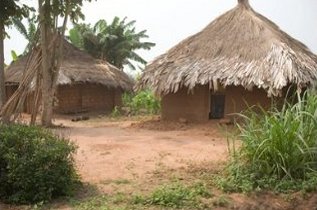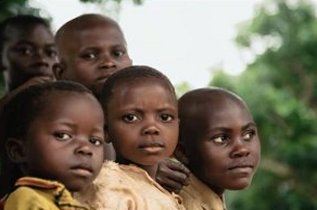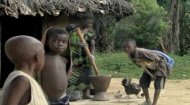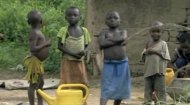Over half of the population of the Democratic Republic of Congo lives in rural areas, typically in scattered villages ranging in size from 10 to 25 homes up to 150 to 200. Many of these inhabit the savanna woodlands of the south-central regions. Most rural housing units are traditionally made from bamboo, straw and mud (below) while those in more urban areas are made from more durable materials and contain more rooms. Most households comprise an average of 5.3 members with around a quarter of them headed by women with most families in western areas of the country tending to be matrilineal, with the mother's brother as the male with the greatest authority in the family, rather than the husband although in other areas of the country, patriarchal and polygamous families, as well as combinations of these, are common.
 The agricultural sector in the Democratic Republic of Congo (mainly growing cassava, yams, plantains, rice, and maize with cash crops including coffee, palm oil, rubber, cotton, sugar, tea, and cocoa), provides the livelihood for over 60% of the population and generates 19.7% of the country's GDP yet, despite having 80 million hectares of arable land, of which 4 million hectares are irrigated, together with many rivers providing rich fish resources, the country cannot ensure food security.
Life in a village within the Democratic Republic of Congo (DRC) operates on a rhythm dictated not by clocks but by the sun, the seasons, and the immediate needs of survival. Long before the official sunrise, the day begins with the sounds of communal awakening: the crowing of roosters, the light scraping of hoes, and the steady, rhythmic pounding of a mortar and pestle as women prepare maize or cassava for the day’s meals. These communities are often remote and disconnected from the national grid, meaning daily activities are driven entirely by subsistence agriculture and the need to gather basic resources.
For the women and older children, the early morning is dedicated to the most vital tasks: sourcing water and firewood. Access to clean water is rarely immediate; this often involves long, strenuous treks, sometimes miles, to a river or borehole, carrying heavy plastic containers balanced skilfully on the head. Simultaneously, others head out to the champ (field), the heart of village sustenance. Cultivation relies heavily on manual labour, with crops such as cassava (the staple base for fufu, a paste made from flour and water served with a sauce made from tomatoes or peanuts), maize, and plantain being tended. Another popular food is shikwanga, and meals are traditionally prepared using an outdoor wood or charcoal fire. Most rural families eat with their hands, with men and the women and children often eating separately.
The men’s responsibilities focus primarily on heavier labour, infrastructure, and protection. This can involve clearing new tracts of land for cultivation, hunting and fishing, or maintaining the thatched roofs and mud-brick structures that make up the village. In the centre of the community, often under the shade of a wide tree, the village chief and elders gather to discuss local issues, adjudicate disputes, and coordinate communal efforts. Social life and community governance are tightly intertwined, ensuring that decisions are collective and that the traditional systems of support remain strong.
Midday is marked by the heavy heat, a period where activity slows down until the late afternoon. This is when the main meal is usually prepared, a process demanding time, patience, and the collective effort of the household. A typical evening plate consists of fufu or ugali (a dense carbohydrate paste) served alongside pondu (cassava leaves cooked with palm oil) or fish. As the sun begins to set, the village comes alive again with social interaction. Children gather to play games, and adults convene to share stories and news.
Without electricity, the noise of modern life is absent. The evenings are illuminated sparsely by crackling fires, kerosene lanterns, or simple palm oil lamps, casting long shadows and fostering an intimate atmosphere. The lack of artificial light means that the day ends relatively early. Resilience is the defining feature of this existence; life in a DRC village is characterised by constant, physically demanding work, but it is also one bound by close kinship ties, profound respect for tradition, and a deep reliance on the community structure for security and survival. For more about life in the Democratic Republic of Congo, check out the video and articles above.
|










